what is the greatest danger to firefighters performing vertical ventilation
Back to basics – sounding and walking on the roof, using roof ladders, working from an aeriform, cutting the hole and punching through
Vertical ventilation is an essential and effective fireground tactic.
For well over 100 years, vertical ventilation has been used by the fire service, proven every bit a feasible ventilation method on thousands of incidents across America and beyond. In fact, it has long been considered the optimal method of ventilation.
In some departments, it is nonetheless the best option due to budget constraints that would prohibit the buy of positive-pressure ventilation (PPV) fans. And depending on what the fire conditions are, it may literally be the just option.
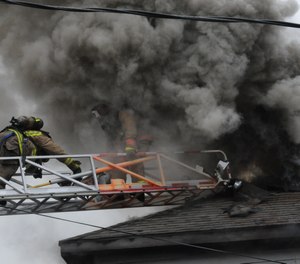
True story: The ladder truck gets it washed
A ladder visitor was traveling downwards a tight residential street, when they rolled upwardly on a woods-frame residential structure with heavy smoke pumping from every crack in the building. The humidity was high that morning time. The smoke was initially lifting and so falling to the ground level, making it difficult to see even while exterior the building.
Neighbors and other bystanders were yelling and pointing at the house, indicating that there were children inside.
The ladder visitor officer radioed dispatch, brash them of the burn down and requested a box alert, all while trying to ready as quickly as possible.
Once the crew was geared up, they attempted a chief search. The crew entered a door on the bravo side. As the officer made entry into the goose egg-visibility weather condition, he chop-chop began to run across items not typically constitute within one's residence – outset a mattress on the floor right in the entryway, then a shopping cart, then a push-mower, and so rolled-up cyclone fencing.
As the company officer continued on, it felt like he was also walking upward, not like a run of stairs, merely more like a mountain of garbage. Presently the officeholder'due south helmet bumped the ceiling.
The officer stopped and asked himself, "Do I continue on or do I abandon the search?" At this point, the company officer is no more than 10-12 feet inside the doorway, and they were still the only company on location.
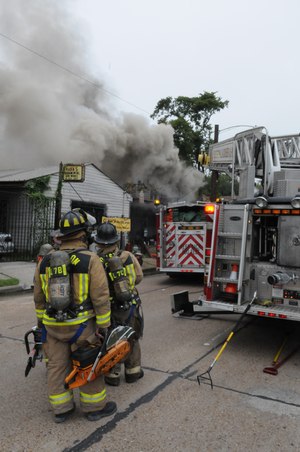
The officeholder decided to abandon the search, opting for vertical ventilation.
As the company returned to the blastoff side to retrieve the necessary equipment to perform vertical ventilation, the officeholder saw that the ladder company chauffeur had already set up everything upwards to make access to the roof – and the vent saw was already running.
The coiffure grabbed the saw from the chauffeur and climbed the ladder. The coiffure cut a dainty-sized hole on the pitched roof, and heavy smoke began pumping out. Equally the crew left the roof, heavy burn down began showing from the pigsty.
The ladder company then re-entered the residence. As the company walked through the business firm – yes, walked – they could see clear every bit solar day, that is, until they made it to the kitchen. The unabridged stove, sink, cabinet and pantry area was gratuitous-burning, and all the products of combustion were exiting directly through the ventilation hole the crew had only cut.
The company officer and crew finished the primary search and exited the residence to call up some pump cans to initiate extinguishment, while at the same time, the start engine company arrived on scene. The ladder visitor officer directed the engine company officeholder to the kitchen and the fire was quickly extinguished.
What is vertical ventilation?
Vertical ventilation is the removal of super-heated toxic gases and smoke by allowing it to take its natural traveling path – UP!
Fire companies make this possible past accessing the roof with a ladder, saws and other tools, and making an opening on the roof'south exterior, and then punching the ceiling out with another tool. The final outcome of this tactic is that the super-heated smoke and toxic gases get out the edifice on their ain. Vent crews simply provide the path of to the lowest degree resistance past cutting a hole in the roof decking large enough to release whatever products of combustion under pressure while bars inside the structure.
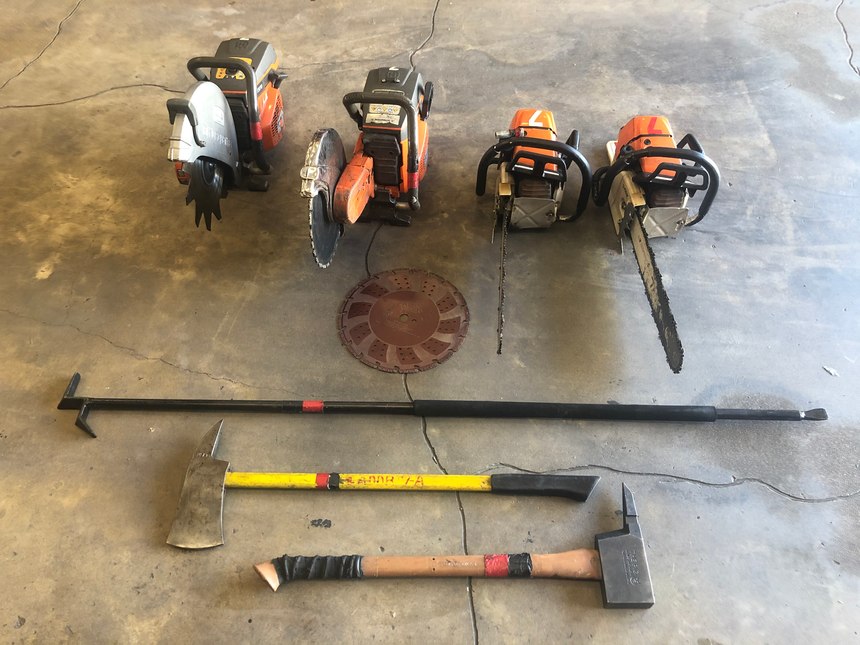
Recommendations for the company officer
Most members will receive minimal preparation, including hands-on training, earlier going to the roof for their start time. Let's train them to be safe. Allow's train them for that experience right here.
Training at this level is the company officer's responsibility. The company officeholder needs to start by explaining every aspect of when, how and why the crew will perform vertical ventilation.
The visitor officer leads the way on this tactic, and they are responsible for grooming their crew to the level needed to complete the task safely. Every action must be explained and practiced over and over until at that place is complete understanding. Information technology starts with the grooming, but in one case on scene, the visitor officer should assume the position of a formal roof safe officer.
The officeholder decides how the roof will be accessed and where the ladder will go, the path the coiffure will travel when walking on the roof, and where the hole will exist cut. The company officeholder then supervises the coiffure doing the actual cutting, making sure they do not walk on their cuts, that they exercise not step off the roof, and that they do not walk anywhere that has non been checked for weakness.
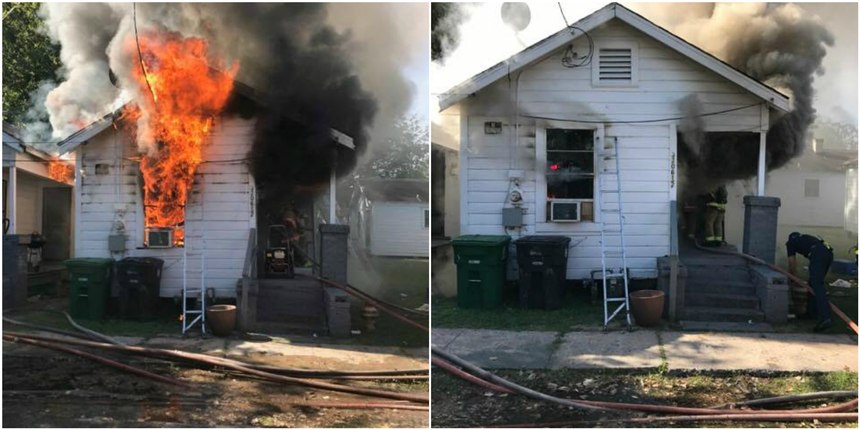
Sounding the roof
Sounding the roof should not exist accomplished with a size 10 kicking. If your boot goes through, you are already in trouble. Sounding the roof is likewise not accomplished by simply borer an axe head inches in forepart of each step taken.
Sounding should be achieved with a 6-, 8- or 10-foot roofhook or other tool with some length to it. The thought is to bulldoze the tool head through the roof as you walk to the location where ventilation is to take identify. Once again, yous want to strike the surface of the roof, non tap it.
When the tool that is 6, 8 or 10 feet out in forepart of you goes through the roof decking, Cease. Maybe even take a step back and so have the crew commencement cutting.
Walking on the roof
When walking on a pitched roof, we want to walk on the strongest areas as much as possible. The strongest areas of a roof are the ridges and valleys. This is where the lumber is reinforced with beams. Nonetheless, proceed in mind that many of today'southward modernistic peaked roofs practise not have a ridge board at all. It is important that every crewmember follows the officeholder sounding the roof and that they not stray from the path.

When the officer decides where to cutting, they will as well sound out a safe working area on the decking that the fire crew should not go beyond. The officer will then discover and ensure the condom of the crew as they work on opening the roof.
Roof ladders
Roof ladders make working on the roof much safer. Even on sketchy or questionable roofs, vertical ventilation can still exist accomplished considering the roof ladder will support the entirety of the fireman's weight and spread it evenly betwixt the ridge and load-begetting exterior wall.
If staffing allows, a second roof ladder is improve. This allows 2 members to cut a single, merely bigger, ventilation hole without e'er stepping human foot onto the roof.
Roof ladders are non always an option, though, sometimes due to roof design. Proper sounding techniques become imperative in these situations.
Working from an aerial device
Working from an aerial device is also a good choice, if bachelor. This method requires even more training, nonetheless, to be efficient and effective. It requires coordination betwixt the firewoman doing the actual cutting and the operator at the turntable. I take seen good outcomes from crews that railroad train regularly; unfortunately, I accept as well seen fine examples of a complete waste product of time and resources.
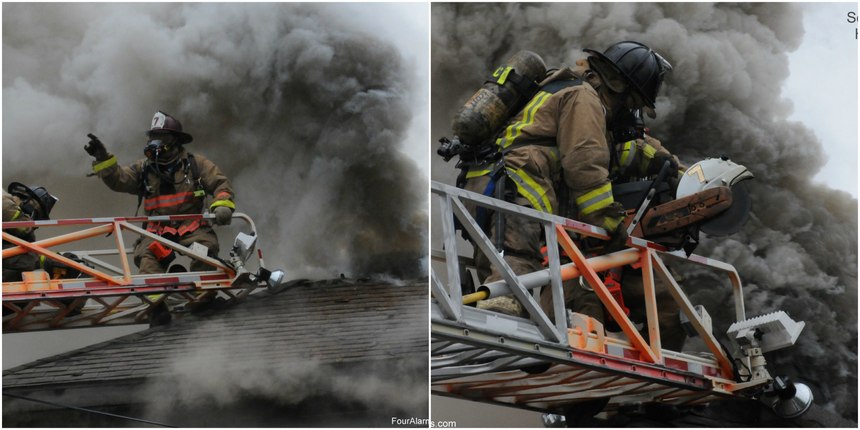
Cutting the pigsty
At that place are many ways to cutting a pigsty in the roof decking. My advice is to go along it uncomplicated. Avert the new techniques yous might discover on random YouTube channels directing you to reposition your feet or walk around a lot or fifty-fifty techniques that require you to pull the saw out of the decking more times than yous would actually cut.
Ever shoot for a bigger hole. A 4 10 4-pes hole gets you a 16-foursquare-human foot hole, whereas a 6 x 6 gets you a 36-square-pes hole.
There'due south a maxim among firefighters regarding ventilation holes. In one's caput and in the textbooks, a hole should get-go of at 4 x 4 minimum. Well, the college the roof and the steeper the pitch of that roof, combined with actual fire conditions, the smaller the ventilation hole gets. This is due to lack of proper training and feel, plus a real presence of fright or discomfort.
When cutting, you lot want to sentinel the depth of your bar or bract for two reasons: 1) Nosotros do non want to cut through any supporting members under the decking, and ii) we exercise not want to choice up or draw in any wiring or ductwork that may be fastened to the underside of the decking in a low-pitched roof. Picking upward the wiring inside ductwork volition put a complete stop to what should take been an otherwise quick operation. You will now be forced to use that pick-caput axe we all hope someone remembered to bring in cases like this.
A trivial trick to save some time or make the vent hole bigger: If you run across a ridge vent installed on a peaked roof, practise not waste product time in making a meridian cut. Your vertical cuts will be enough. The top of the decking is no longer attached to the ridge board, merely to the rafters. Instead, add that top cut to your vertical cuts for a larger hole with the same number of cuts.
Punching through
Ventilation is not complete until y'all punch through the ceiling. The ceiling must exist opened to let the smoke and heat to enter the attic infinite then exit the vent pigsty.
Proper tool selection is important here. Y'all demand a tool heavy enough to make easy work of the job and with a large enough surface area to remove big sections at a fourth dimension. A simple motorway pole would not be my kickoff option for this part. A roofhook or trash claw would exist a good selection.
Also, sizing-up the roof comes into play with the tool selection for this office.
The steeper the pitch of the roof, the longer your tool pick will need to be. You do not want to exist on the roof with your favorite 6-pes roofhook when you need a 10-foot roofhook.
Some roof pitches will require the ceiling to exist opened from the inside to allow for venting.
Coordinated set on
Today's definition of coordinated assault is a little different than in years past.
In the past, the idea of vertical ventilation was to permit the pressurized smoke and heated air to escape before sending in the attack crew, making conditions safer by providing visibility and even preventing a backdraft. This also immune for a more rapid advance to the seat of the fire.
Research coordinated by both NIST and UL has provided firefighters evidence to guide period path direction decisions. Vertical ventilation is part and parcel to this discussion. The timing for the decision to provide vertical ventilation does need to be carefully coordinated with the engine company. In locales with close-in companies, or where robust engine and truck crews get in together, early vertical ventilation is a great strategy to improve conditions for the chop-chop advancing engine crew, who will immediately utilise water.
In locales where staffing is at a premium, early vertical ventilation in the absence of a ready hoseline could mean the difference between salvaging part of the building or ending up with a parking lot.
Experience and training along with crew size and coiffure integrity will be critical to the ventilate/not-ventilate decision and/or the decision on whether to get to the roof.
Tactically aware ways prophylactic
Vertical ventilation has been i of the fundamental tactics since the dawn of modernistic firefighting.
It is as simplistic in use as a smoothbore nozzle. If you open a smoothbore nozzle, the water comes out based on the size of the tip and pressure at the pump. It's that bones.
If you ventilate the roof, the smoke and heat come out at a rate equivalent to the size of the opening and pressure inside the house.
The only reason to fear vertical ventilation is for lack of training and agreement. Our members must exist trained for complete understanding – understanding when vertical ventilation is needed, determining if the roof is condom to operate on, understanding the method of access, knowing the methods that are going to be used to really cut the ventilation hole and looking for ways to make vertical ventilation safer.
Permit'southward train our members to be prophylactic, comfortable and tactically aware of vertical ventilation operations.
[Read next: Grooming time: A company officeholder's guide for fugitive risk ]
[Next: Take the quiz: How much practise you know near vertical ventilation?]
About the author
Chris DelBello is a 31-year veteran of the burn down service. He currently holds the rank of senior helm with the Houston Fire Section, working in the Midtown District. He is as well the district training officer, which encompasses all the stations in downtown and midtown. DelBello holds a Training Officeholder II certification and serves as an adjunct instructor with Houston Community College. Connect with DelBello via email.
Source: https://www.firerescue1.com/fire-products/ventilation/articles/vertical-ventilation-a-firefighters-ladder-to-roof-guide-shezGumWxQoJFSKU/
0 Response to "what is the greatest danger to firefighters performing vertical ventilation"
Post a Comment